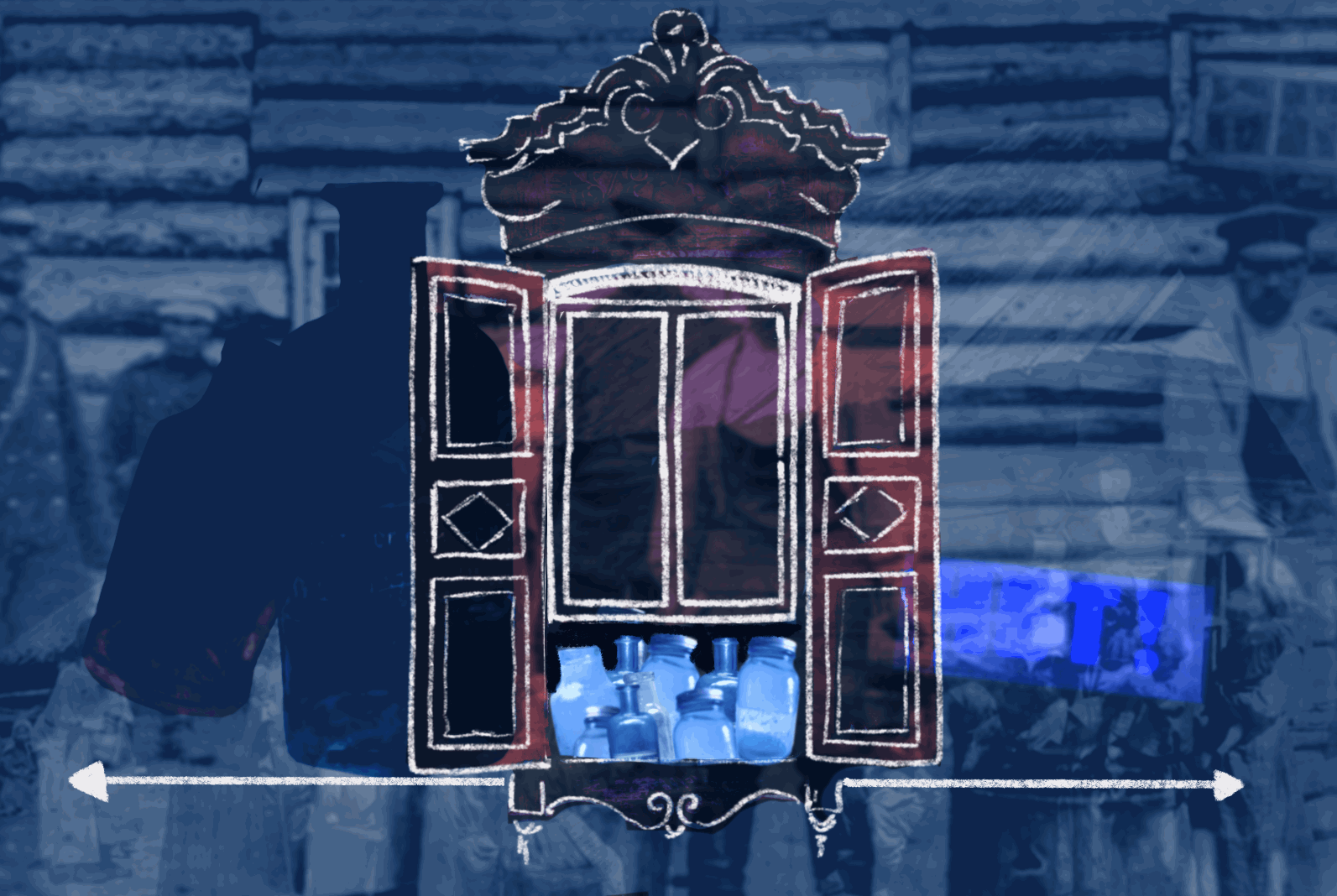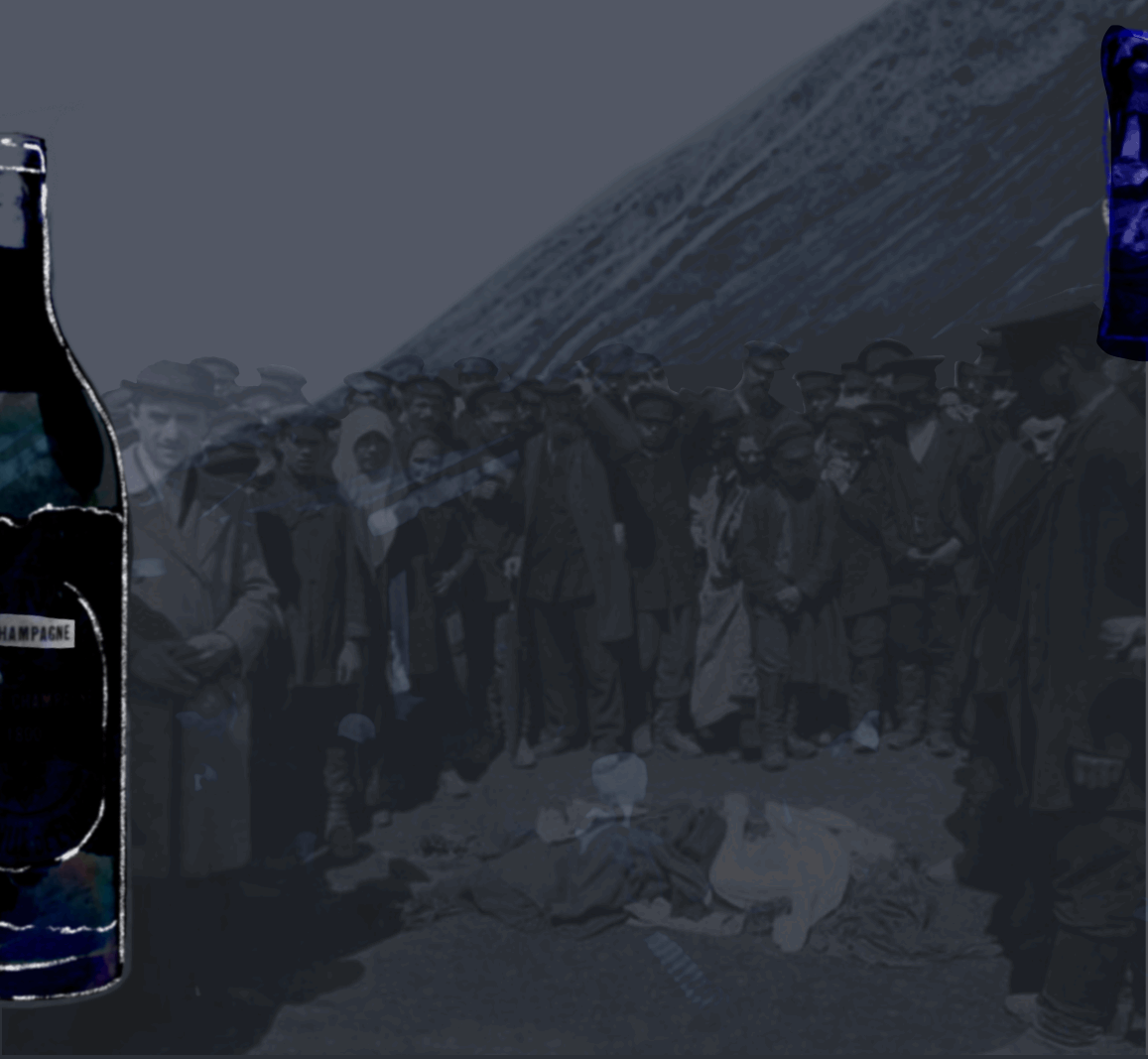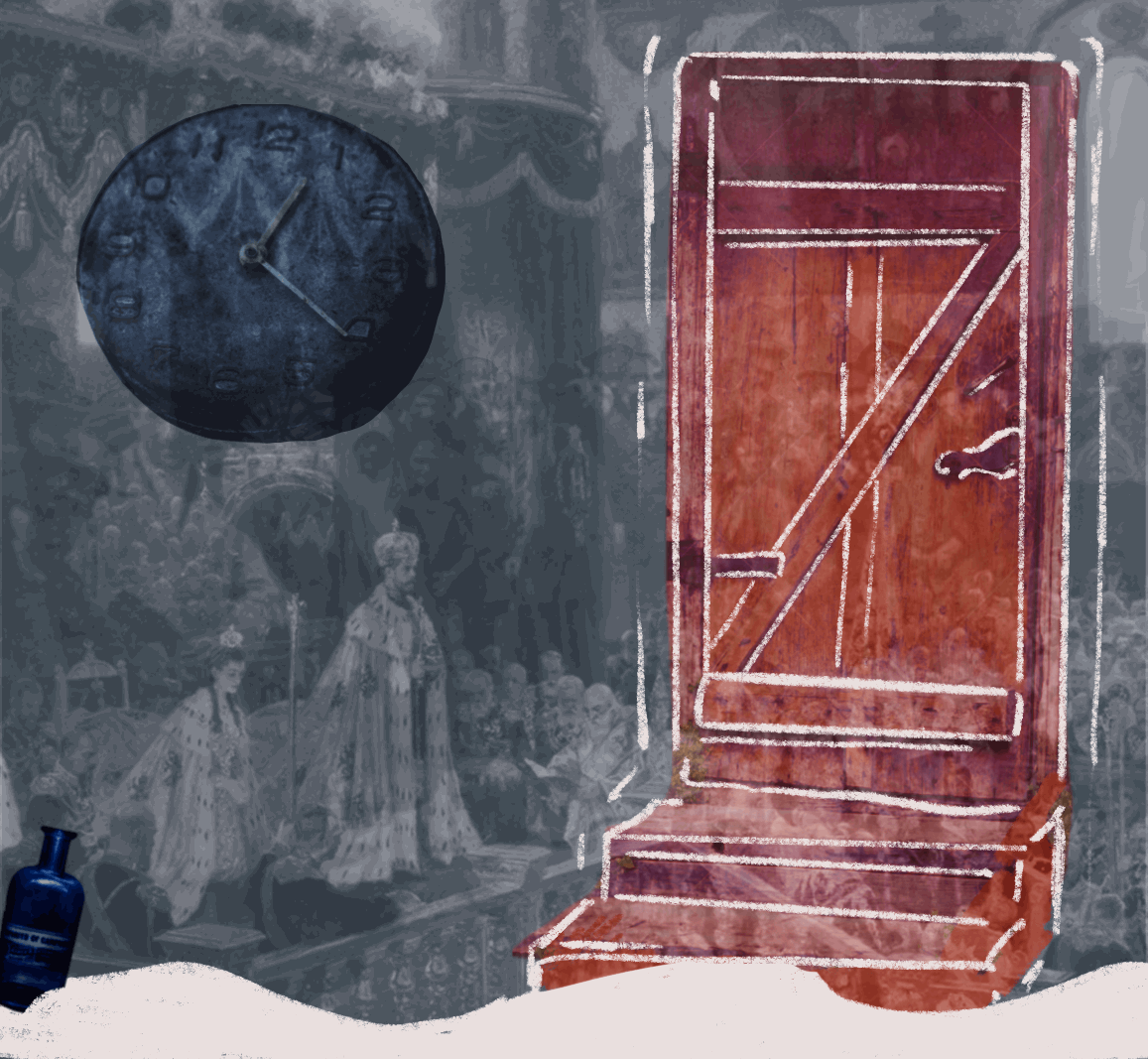It’s 5 a.m. on May 30, 1896, but the sun is already high enough above the horizon to illuminate the forms of more than half a million Russians. Four days earlier, Tsar Nicolas II and his wife, Tsarina Alexandra Feodorovna, had been crowned. In five hours, a celebratory feast is set to begin on Khodynka Field, a training ground for the Russian military set on the northwestern edge of Moscow. One-hundred-and-fifty food stalls, 20 bars, and a series of makeshift theaters have been erected to serve 30,000 buckets of free beer, along with pretzels, sausages, and gingerbread. A limited number of guests are set to receive a commemorative enamel mug bearing the symbols of the imperial crown and coat of arms.
As the sky pales, the mood among the still-growing crowd is boisterous, yet tinged with an undercurrent of anxiety. Most of the onlookers camped out overnight. Already, rumors are beginning to spread that there may not be enough beer and mugs to go around. For many here, the stakes are high—it may be the first solid meal they’ll have in days. Peasants from the rural region surrounding the Volga River are still reeling from the famine of 1891-92, which killed as many as 400,000. At this time, the average life expectancy for a Russian man is 30 years old, and starvation is a common cause of death.
No one knows who started the stampede, but within minutes a crush of bodies is pressing towards the front of the esplanade. The 1,800 police officers on duty are no match for the sheer force of the mob. As thousands charge toward the tented stalls, they fail to notice the uneven, muddied terrain at their feet. Khodynka Field is riddled with pits and trenches—the remnants of training exercises—most of which have been covered haphazardly with wooden planks. Bodies crash down into muddied earth to be trampled and suffocated underfoot. Within minutes, Khodynka Field has turned into a site of slaughter. By official counts, 1,389 people are dead and at least 1,300 are injured in one of the worst stampedes in human history.
Vladimir Gilyarovsky, a veteran war reporter, would later write in his memoirs, “About 200 of Russian and foreign correspondents had arrived in Moscow by these days, but I was the only one who had spent the whole night among the crowd of many thousands who were choking and dying at the Khodynskoe field.”
Nicolas II didn’t know it that day, but his fate was already sealed. By the time he and his wife appeared to greet the crowd around 2 p.m., the corpses had been dragged off the field. That very night, the Tsar attended a lavish ball at the French embassy hosted by Gustave Lannes de Montebello. By most accounts, the Tsar was horrified at the carnage and had not wanted to attend, but the political risk of causing a rift with the French was too great. Nevertheless, the damage in the eyes of the public was done. No amount of hospital visits or donations could undo the image of the Tsar drinking Champagne while hundreds lay dying. The nickname “Nicolas the Bloody” would haunt him until his assassination by the Bolsheviks in 1918.
That blood-soaked morning on the training fields of Khodynka would not be the last time that alcohol played a critical role in shaping the course of Russian history. Booze features in the rise and fall of both the Russian Empire and the Soviet Union. One of the only things Nicolas II and Vladimir Lenin agreed upon ideologically was the power of alcohol as a method for controlling the peasantry, but also as a dangerous opiate of the masses. Both the tsarist regime and the Bolsheviks that followed would wield it and withhold it when it suited their interests.
While vodka would always be Russia’s primary poison of choice, brewing also had a long, local history. “Obviously the Russians are more known for the vodka than the beer, but that doesn’t mean there weren’t indigenous traditions of brewing going back for centuries,” says Mark Schrad, author of Vodka Politics: Alcohol, Autocracy, and the Secret History of the Russian State. “If you go back 400 years, the kabak, or tavern, in Russia was really no different than the tavern in other parts of Western Europe. You’d have your Ales and your beers, your mead, and your kvas.”
“Obviously the Russians are more known for the vodka than the beer, but that doesn’t mean there weren’t indigenous traditions of brewing going back for centuries. If you go back 400 years, the kabak, or tavern, in Russia was really no different than the tavern in other parts of Western Europe. You’d have your Ales and your beers, your mead, and your kvas.”
What changed is that Tsar Alexander III decided to seize control of vodka production from the petty aristocracy and declare a state monopoly in 1893. It was hardly unprecedented: Ivan the Terrible had handed taverns over to state control in 1648. Cheap to produce and with a near-infinite shelf life, vodka was a gift to the tsarist regime and made up a full third of the government’s income by 1914.
“One of the things that happens when the tavern becomes a monopoly of the government is that vodka becomes incredibly profitable,” Schrad says. “There were some great brewers in the old Russian Empire, but they get elbowed out because the state has a monopoly on vodka.”
Unfortunately for the imperial budget, something else happened in 1914. As Russian soldiers were marching to the Eastern Front in World War I, Nicolas issued a sweeping ban on alcohol. Although the primary incentive was to keep the troops from stumbling into battle inebriated, the impact was disastrous. The result of the prohibition was a thriving, nationwide black market for home-brewed and -distilled booze, along with a weakened, financially crippled tsarist regime.
The Tsar wasn’t the only figure who favored clamping down on consumption. When Vladimir Lenin returned to Russia after a decade in exile in Western Europe, he was eager to do away with all traces of the Romanov dynasty. Yet after November 7, 1917, when the Bolsheviks seized power in the October Revolution, they decided to keep the prohibition in place. While not a teetotaler himself, Lenin viewed alcohol—like religion and tobacco—as a weakening force on the proletariat.
“Whatever the peasant wants in the way of material things we will give him, as long as they do not imperil the health or morals of the nation,” Lenin declared. “But if he asks for ikons or booze—these things we will not make for him. For that is definitely retreat; that is definitely degeneration that leads him backward.”
Lenin and his Marxist cohort’s concerns weren’t entirely unfounded. In August 1914, violent riots broke out in 230 taverns as furious Russians demanded a drink. Having risen to power supported by an angry mob, the Bolsheviks worried about what might happen if the tables should turn on them. Although the provisional government at the time loosened the restrictions to allow for sales of beer and wine in some areas, they maintained a hard ban on distilled liquor.
“Whatever the peasant wants in the way of material things we will give him, as long as they do not imperil the health or morals of the nation. But if he asks for ikons or booze—these things we will not make for him. For that is definitely retreat; that is definitely degeneration that leads him backward.”
“For Lenin and the Bolsheviks, it was a nightmare, because they saw it as a threat of counter-revolution,” Schrad says. “They were constantly fearing that just as they had come to power by overthrowing the government, so they could be overthrown. So drunken disorder was always a big threat.”
Morals were all very well and good, but it wasn’t long before the Bolshevik government was broke. Joseph Stalin, Lenin’s successor, was more of a pragmatist when it came to money matters. In 1925, roughly a year after Lenin’s death, the Soviets got rid of prohibition altogether.
Prior to the 1917 October Revolution, Russian brewing traditions and beer preferences were significantly influenced by other parts of Europe. Bavarian Lagers, Czech Pilsners, and Vienna Lagers were staples in bathhouses and beer halls. Thanks to Peter the Great, who became so fond of British beers on a trip to London in 1698 that he made them mandatory at banquets, Porters were also popular. Catherine the Great was also said to favor Imperial Stouts.
Later, the Soviet government decided to rid all the breweries in Russia of their capitalist trappings. It seized control of breweries’ assets, and swapped in labels it felt better reflected Russian patriotism. Munich-style Lagers became “Ukrainskoe,” or “Ukrainian-style Lagers,” and Czech Pilsners became “Russkoe,” or “Russian.”
The most recognizable beer in the U.S.S.R. started out as a Vienna Lager brewed by a member of the Austrian aristocracy. Alfred Josef Marie Ritter von Vacano first began brewing in the city of Samara in 1880. Zhigulevskoye Brewery, named for the nearby Zhiguli hills, quickly developed a reputation for quality, thanks to the use of ingredients including the clear water from the nearby Volga River and toasted malts imported from Vienna.
The Bolsheviks didn’t think too highly of a foreigner making a mint on their territory. After seizing control of Samara in 1918, they banished von Vacano. Though the brewer was a Russian citizen by then, he would die in exile in Austria just over a decade later with barely a cent to his name.
“‘Prior to the 1917 October Revolution, Russian brewing traditions and beer preferences were significantly influenced by other parts of Europe. Bavarian Lagers, Czech Pilsners, and Vienna Lagers were staples in bathhouses and beer halls. Thanks to Peter the Great, who became so fond of British beers on a trip to London in 1698 that he made them mandatory at banquets, Porters were also popular. Catherine the Great, the wife of his grandson, was also said to favor Imperial Stouts.’”
In 1934, one of Stalin’s men, Anastas Mikoyan, took a look at the old brewery and saw an opportunity. He decided to rename the Viennese beer “Zhigulevskoye” after the brewery, in order to erase all traces of its origins. After tweaking the recipe to make it cheaper to produce, Mikoyan sent it to other breweries around the Soviet Union. Before long, it was the most popular—or at the very least, most widely distributed—beer in the U.S.S.R.
To this day, Zhiguli Beer carries a tinge of nostalgia for many Russians, even if it embodies the worst tendencies of the Soviet regime. Like the U.S.S.R., the beer’s story is one of nationalism, selective historical erasure, and a hostile consolidation of power. It also contributed to an inevitable lack of variety. By some accounts, at one point more than 700 breweries were churning out Zhiguli, or some loose approximation of it.
Yet the common Soviet worker was unlikely to complain about his Lagers, provided he was able to get any at all. When the CIA declassified a file of jokes about the Soviet Union in 2017, a recurring theme was the constant shortages of just about everything, and beer was no exception. Russians would line up in the early morning on a weekday clutching jars, glasses, and all sorts of vessels lugged from home to try and get their share. If the beer was lousy, they could always spike it with a shot of vodka—known as a yorsch.
“The beer in the Soviet Union was just universally bad,” Schrad says. “If you left the capital you’d still run into the old Soviet style of beer and it was the worst stuff you could imagine.”
Schrad still remembers backpacking through Crimea shortly after the collapse of the Soviet Union. By that time in the early 1990s, matters were beginning to shift somewhat. Baltika Brewery set up shop in St. Petersburg in 1990, introducing a higher level of quality control than many of the old Soviet-era breweries maintained. Nevertheless, Schrad still has to laugh when he recalls a man stopping him and insisting on taking him to the best beer house in town.
“I was wondering if this guy was going to murder me, but he said, ‘Come with me and I’ll show you our best beer!’” Schrad says. “This wasn’t like one of your luxury Munich beer halls. It was a metal cage. The whole thing smelled like dried fish and BO. Instead of coming from a tap, this guy pulled out a rubber hose and this sludge came out.”
Incredibly, that sludge would not have been classified as booze at all. In 1985, Mikhail Gorbachev once again clamped down on drinking throughout the U.S.S.R. Producing or selling wine or vodka at home became a jailable criminal offense. A slew of Soviet propaganda posters attested to the evils of alcohol. There was only one exception: beer. Even after the disastrous dry laws failed, the Russian government legally considered any beer with 10% ABV or under to be a food. It could legally be sold to children and retained this dubious distinction all the way until 2011.
These days, beer consumption in Russia is on the rise—as of 2018, it was the sixth-largest beer-consuming nation in the world—while sales of the stronger stuff have largely declined in recent years. And while the market for Soviet kitsch means locals can still order a Zhiguli in an old-school bar, there are now more than 100 craft breweries in the nation. Part of that has to do with pragmatism—imported beers became prohibitively expensive after the ruble cratered in 2014—but much of that has to do with a new generation looking to modernize and reshape Russian identity. As history shows, the drinking habits of the nation mirror its shifting social and political climate.












